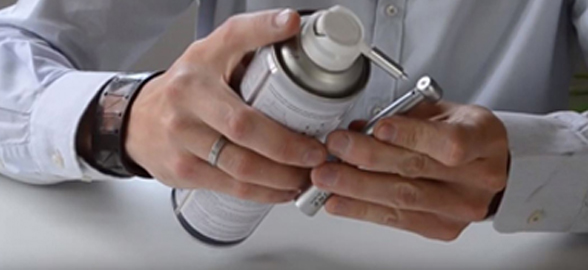Today, fiberglass posts are one of the most widely used alternatives for the reconstruction of endodontically treated teeth that present considerable coronary destruction. That is why in this article we will tell you everything about this type of intraradicular posts and we will give you some advice to take into consideration when choosing this treatment. We will also talk about adhesion, a crucial factor for the success of the procedure, and how you can choose the best cement for each case. Shall we start?
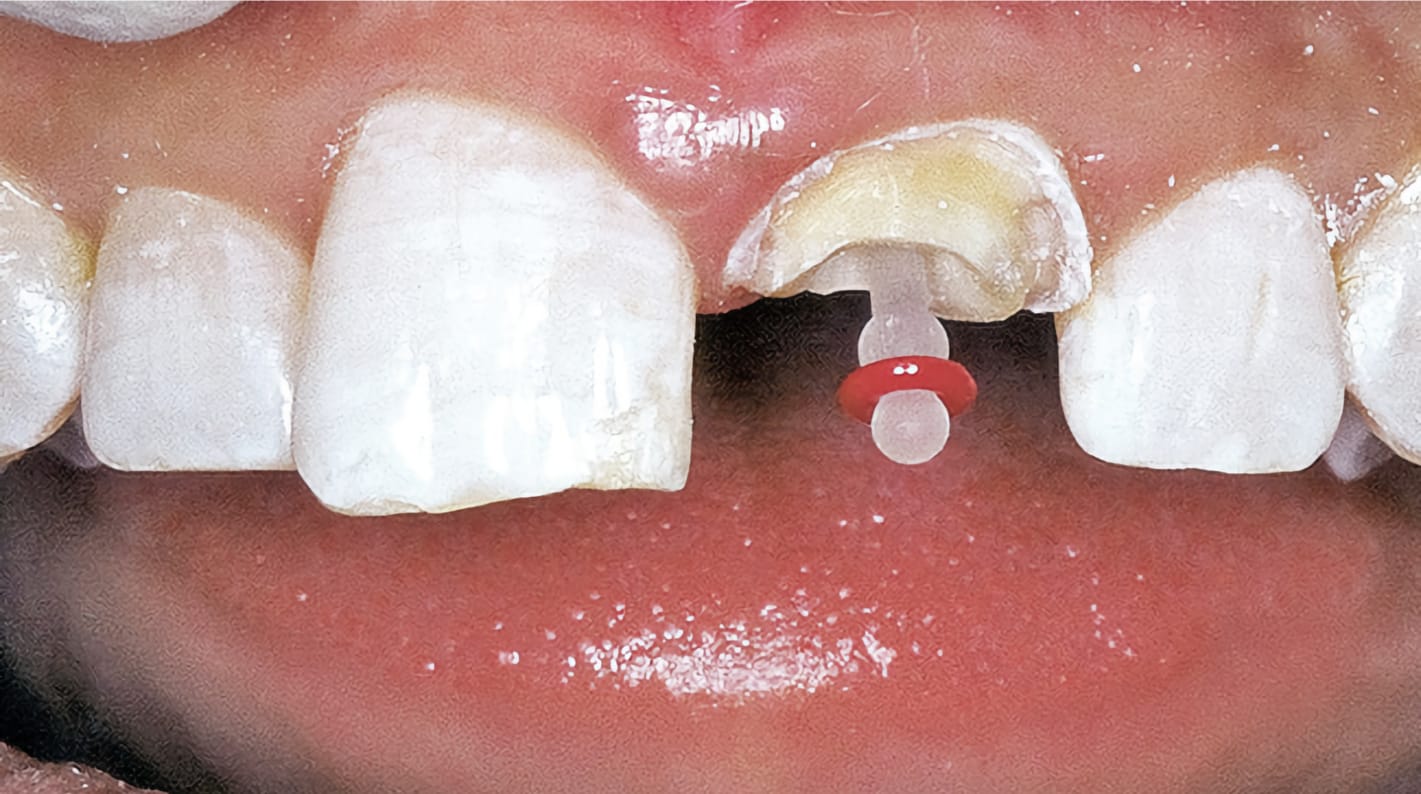
Everything you need to know about fiberglass posts
The fiberglass posts are an intraradicular retainer that serves as an anchor for the reconstruction of a stump. It is a conservative procedure with the remaining dental structure compared to the traditional cast posts and they are indicated when more than half of the dental structure has been lost. The prefabricated posts are one of the most common therapeutic options because they are easy to manipulate, usually provide high biomechanical success and allow the reconstruction of the stump in a single session, however, the tooth to be treated must meet a series of requirements, such as:
- Absence of caries remains in the coronal third of the root canal
- Not be suspicious of fractures or root resorption
- Appropriate canal length and thickness
- Appropriate canal morphology
- Good apical seal
But it is not only the teeth that must meet the requirements, these are also required of the fiberglass posts, which must be:
- Biocompatible
- Able to protect the root and reduce the risk of fractures
- Provide sufficient retention within the root
- Reduce leakage risks
- Preferably be aesthetic
- Be visible radiographically
Why are posts made of fiberglass?
The fiberglass gives the intraradicular posts advantages such as adhesion to the root canal and better distribution of applied forces, reducing the risk of of root fractures. The fiberglass posts are made of a structure of reinforcing fibers immersed in a polymerized resin matrix. These fibers have different configurations: braided, longitudinal or woven; and are oriented in the longitudinal axis of the post, reaching a diameter of between 6 and 15 µm. According to each type of post, the amount of fibers varies between 25 and 35, and if we observed a cross section of the post we would see that between 30 and 50% is occupied by fibers that are strongly adhered to its resin matrix, because they have previously been silanized, so that the forces can be transmitted from the matrix to each of the fibers and, in turn, these are capable, as a whole, of being a powerful reinforcement of the dental structure.
How to choose the best fiberglass posts?
There is a large number of fiberglass posts on the market and one of its varieties is the cross section that can be cylindrical, conical, double conical, frustoconical, etc. But which is better? The latest studies have agreed that cylindrical posts have greater retention than conical posts and, meanwhile, double conical posts are more adaptable to the shape of the canal.
Another factor to consider is the head of the posts, some have a coronal head or notches to increase retention with the core. Everything helps!
On the other hand, if you have to choose between a fiberglass posts or a carbon fiber posts, you should know that the latter option, despite having physical properties similar to dentin and having extensive resistance and durability qualities, its main disadvantage is its dark color, not suitable for aesthetic restorations.
Also, when choosing a fiberglass post, you should pay attention to the radiopacity, an important quality to correctly visualize the position of the posts and its subsequent control.

Image: Comparison of radiopacities in different brands of fiberglass posts. Source: The Dental Advisor, Research Report No. 70 – June 2015
Fiberglass Post vs. Cast Post
Despite the fact that cast posts require a greater investment of time, material and dental laboratory costs, today there is still a controversy as to which of the two is better, since most of the results on which the conclusions that favor one or the other are based are obtained from in vitro studies. Accordingly, cast posts would have greater resistance to fracture than fiberglass posts; however, the fracture resistance of the latter is not insufficient to resist masticatory forces and We can add to this that adhesive cementation offers better mechanical stability.
In terms of aesthetics, it is undeniable that fiberglass posts are infinitely superior to cast posts and they are also superior in their adhesive capacity, since cast posts can also experience corrosion.
As we have said, fiberglass poles have a greater possibility of fracture than cast poles, but the difference lies in the prognosis, since in case of fracture of a fiber post, only the coronal third will be affected and the post would simply have to be replaced. On the other hand, cast posts are usually associated with root fractures that finally end in extraction and subsequent implantation.
The reason why cast posts are more prone to root fractures is that the forces are concentrated in uncontrolled areas and there is also friction along the dentin walls and this Friction causes stress, promoting the appearance of root fractures. Fiberglass posts, being capable of adhesion to dentin and the stump, have a elastic modulus similar to dentin and better absorb forces, avoiding root fractures.
Ultimately, the decision of one treatment or another will be clinical and will be based on the amount of hard tissue lost. If you decide to use a fiberglass post, you should try to remove as little dental tissue as possible and use a good adhesive cement in order to achieve the success of the treatment.
Fiberglass poles: our recommendations:
At Dentaltix we have the best brands of fiberglass posts. Here are some of our recommendations:
Glass Fiber Post: Fibreglass Post Kit
VIDU brand fiberglass posts have a cylindrical shape and a conical tip. They are specially designed for teeth with a moderate amount of residual coronal tissue and canals with small sections. Its surface is highly retentive to facilitate post-cement adhesion.
- Translucent.
- High resistance to bending.
- Radiopaque.
- Retentive surface.
- Kit includes posts and drills.

RelyX FiberPost 3M
RelyX Fiber Post is a complete system specifically designed to achieve the best results, as it offers exceptional resistance to fatigue. In addition, it has an elasticity very similar to dentin, which provides great resistance to masticatory forces.
- Greater mechanical retention of the core build-up material.
- Long-term stability.
- Greater resistance to fatigue.
- Translucent, highly aesthetic.
- Radiopaque.
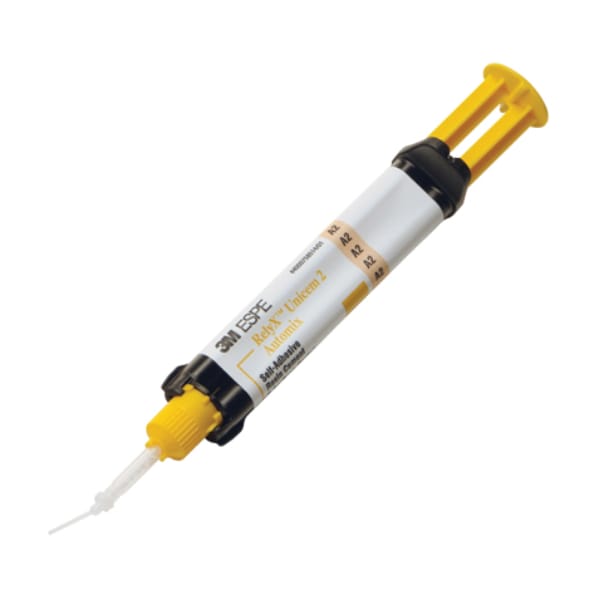
mPost Glass: Medicaline Fiberglass Post Kit
Medicaline mPost Glass posts have a cylindrical shape with a tapered tip to perfectly adapt to the shape of the tooth. In addition, its retentive surface will ensure that it remains firmly adhered to the cement.
- Rough surface for greater retention.
- Radiopaque.
- Elastic modulus similar to dentin.
- Cylindrical shape for better adaptation.
- Includes 18 posts and 3 drills.

Adhesion of fiberglass posts
Adhesion is a critical factor to consider for the successful cementation of a fiberglass post. This is done with resin cements that must meet a series of requirements such as:
- Be biocompatible
- Tensile strength
- Low or no solubility
- Anticariogenic capacity
- Low viscosity
- Corrosion resistance
- Appropriate film thickness
Resin cements
Resin cements are the optimal materials for cementing fiberglass posts due to their ability to control their polymerization. A resin cement is a low-viscosity composite resin that has a silanized inorganic filler in its matrix. Its use requires a dentin adhesive and its polymerization can be self-curing or light-curing, therefore, dual. We can classify resin cements as:
Self-etch and self-adhesive resin cements
They are the most widely used and are indicated for adhesive cementation of root posts. They have the advantage of being easy to apply, not needing etching, primer or adhesive and, therefore, it requires fewer steps, reducing the probability of error.
Its adhesion mechanism is based on the phenomenon of dentin hybridization and also the inclusion of the smear layer in the hybrid layer. With this cement you can achieve a very low thickness layer.
Due to its simultaneous self-adhesive and self-etching capacity it demineralizes and infiltrates the resin at the same time, facilitating the evaporation of the solvent and generating an adequate monomer-collagen interaction that acts as a dentin densitizer.
At Dentaltix we have a wide variety of self-etching and self-adhesive resin cements that will simplify the cementation process, save steps and errors. Among some of them, we recommend:
m-Zem Plus Medicaline Self-Adhesive Resin Cement
m-Zem Plus is a dual-cure self-etch and self-adhesive resin cement in a self-mixing system for one-step use. It also has a fluid texture that makes it easy to apply and remove residue.
- Automix.
- Minimum thickness film.
- Radiopaque.
- Available in A2 and TW colour.
- Includes 8 gram syringe, 10 automix tips and 5 intraoral tips.
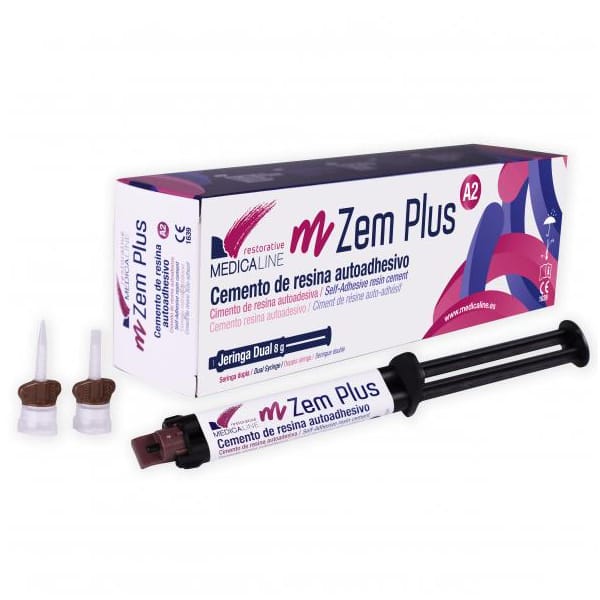
RelyX Unicem 2 Automix Dual Self-Adhesive Resin Cement 3M
3M RelyX Unicem 2 Automix is a high-performance, dual-curing, self-adhesive resin cement with comfortable handling and optimal consistency for both dispensing and application.
- Easy handling, time saving.
- Low risk of bubble formation.
- Long-term stability.
- Durable and secure adhesion.
- Excellent mechanical properties.
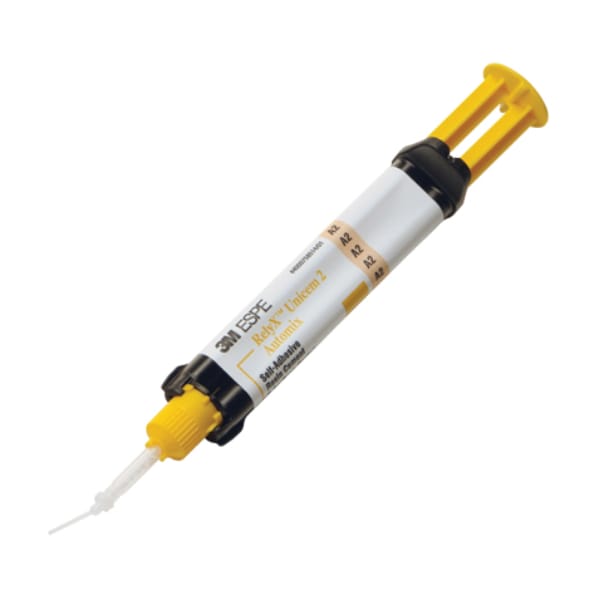
Go to RelyX Unicem 2 Automix Self-adhesive Resin Cement from 3M
Conventional etch resin cements
Unlike the previous one, this cement does require a previous etching with phosphoric acid and the application of adhesive in the preparation. Despite requiring more clinical steps, many authors state that it is the technique that provides the strongest adhesion between cement and dentin.
In summary, self-etch and self-adhesive resin cements have the competitive advantage of their great versatility and ease of use, avoiding errors by reducing the number of clinical steps. These cements have high adhesion strength and low polymerization stress, which makes them the ideal material for cementing your fiberglass posts.

image: Polarized image of an upper canine endodontically treated with a fiber post (FP) and cemented with a self-adhesive cement. The apical seal (AS) of the gutta-percha is 5 mm long.
Finally, we can conclude that fiberglass posts have become the first choice of many dentists when it is necessary to rehabilitate endodontically treated teeth that have lost much of their structure. The glass fibers oriented longitudinally and immersed in a polymerized resin matrix have a modulus of elasticity that is similar to dentin and this allows them to be able to support the different chewing loads with minimal possibility of fracture unlike cast posts. In addition to these resistance and durability properties, the use of fiberglass posts is capable of providing an aesthetic solution to the patient, thanks to its translucency.
A critical step to ensure the success of the treatment is the cementation of the fiber post, this can be achieved thanks to self-etch and self-adhesive resin cements or conventional etch resin cements, the latter, they could present higher adhesion values, however, they would require more steps that would therefore increase the margin of error, the first being a more than advisable option for the successful cementation of the posts.
We hope you enjoyed reading our article. Remember that at Dentaltix you can find a wide variety of fiberglass posts, etchant acids, adhesives and cements of all kinds that will help you obtain the best results with your patients. If you have any questions or comments, do not hesitate to write to us and we also invite you to follow us on our social networks. See you soon!





